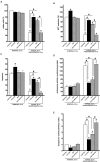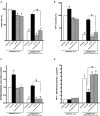SIRT Is Required for EDP-Mediated Protective Responses toward Hypoxia-Reoxygenation Injury in Cardiac Cells
- PMID: 27242531
- PMCID: PMC4868841
- DOI: 10.3389/fphar.2016.00124
SIRT Is Required for EDP-Mediated Protective Responses toward Hypoxia-Reoxygenation Injury in Cardiac Cells
Abstract
Hypoxia-reoxygenation (H/R) injury is known to cause extensive injury to cardiac myocardium promoting development of cardiac dysfunction. Despite the vast number of studies dedicated to studying H/R injury, the molecular mechanisms behind it are multiple, complex, and remain very poorly understood, which makes development of novel pharmacological agents challenging. Docosahexaenoic acid (DHA, 22:6n3) is an n - 3 polyunsaturated fatty acid obtained from dietary sources, which produces numerous effects including regulation of cell survival and death mechanisms. The beneficial effects of DHA toward the cardiovascular system are well documented but the relative role of DHA or one of its more potent metabolites is unresolved. Emerging evidence indicates that cytochrome P450 (CYP) epoxygenase metabolites of DHA, epoxydocosapentaenoic acids (EDPs), have more potent biological activity than DHA in cardiac cells. In this study we examined whether EDPs protect HL-1 cardiac cells from H/R injury. Our observations demonstrate that treatment with 19,20-EDP protected HL-1 cardiac cells from H/R damage through a mechanism(s) protecting and enhancing mitochondrial quality. EDP treatment increased the relative rates of mitobiogenesis and mitochondrial respiration in control and H/R exposed cardiac cells. The observed EDP protective response toward H/R injury involved SIRT1-dependent pathways.
Keywords: cardiac cells; docosahexaenoic acid; epoxydocosapentaenoic acids; hypoxia–reoxygenation; mitobiogenesis; mitochondrial function.
Figures







Similar articles
-
CYP-epoxygenase metabolites of docosahexaenoic acid protect HL-1 cardiac cells against LPS-induced cytotoxicity Through SIRT1.Cell Death Discov. 2015 Nov 23;1:15054-. doi: 10.1038/cddiscovery.2015.54. Cell Death Discov. 2015. PMID: 27182450 Free PMC article.
-
PPARδ signaling mediates the cytotoxicity of DHA in H9c2 cells.Toxicol Lett. 2015 Jan 5;232(1):10-20. doi: 10.1016/j.toxlet.2014.09.029. Epub 2014 Oct 6. Toxicol Lett. 2015. PMID: 25300478 Free PMC article.
-
Cardioprotective effects of CYP-derived epoxy metabolites of docosahexaenoic acid involve limiting NLRP3 inflammasome activation 1.Can J Physiol Pharmacol. 2019 Jun;97(6):544-556. doi: 10.1139/cjpp-2018-0480. Epub 2018 Oct 16. Can J Physiol Pharmacol. 2019. PMID: 30326194
-
Cytochrome P450-derived eicosanoids and heart function.Pharmacol Ther. 2017 Nov;179:47-83. doi: 10.1016/j.pharmthera.2017.05.005. Epub 2017 May 25. Pharmacol Ther. 2017. PMID: 28551025 Review.
-
Therapeutic potential of omega-3 fatty acid-derived epoxyeicosanoids in cardiovascular and inflammatory diseases.Pharmacol Ther. 2018 Mar;183:177-204. doi: 10.1016/j.pharmthera.2017.10.016. Epub 2017 Nov 7. Pharmacol Ther. 2018. PMID: 29080699 Review.
Cited by
-
Assessment of OMT-28, a synthetic analog of omega-3 epoxyeicosanoids, in patients with persistent atrial fibrillation: Rationale and design of the PROMISE-AF phase II study.Int J Cardiol Heart Vasc. 2020 Jul 10;29:100573. doi: 10.1016/j.ijcha.2020.100573. eCollection 2020 Aug. Int J Cardiol Heart Vasc. 2020. PMID: 32685659 Free PMC article.
-
Cardiac Shock Wave Therapy Alleviates Hypoxia/Reoxygenation-Induced Myocardial Necroptosis by Modulating Autophagy.Biomed Res Int. 2021 Jan 19;2021:8880179. doi: 10.1155/2021/8880179. eCollection 2021. Biomed Res Int. 2021. PMID: 33532500 Free PMC article.
-
Cardioprotective Action of a Novel Synthetic 19,20-EDP Analog Is Sirt Dependent.J Cardiovasc Pharmacol. 2024 Jan 1;83(1):105-115. doi: 10.1097/FJC.0000000000001495. J Cardiovasc Pharmacol. 2024. PMID: 38180457 Free PMC article.
-
CircUBXN7 mitigates H/R-induced cell apoptosis and inflammatory response through the miR-622-MCL1 axis.Am J Transl Res. 2021 Aug 15;13(8):8711-8727. eCollection 2021. Am J Transl Res. 2021. PMID: 34539989 Free PMC article.
-
Epoxide metabolites of arachidonate and docosahexaenoate function conversely in acute kidney injury involved in GSK3β signaling.Proc Natl Acad Sci U S A. 2017 Nov 21;114(47):12608-12613. doi: 10.1073/pnas.1705615114. Epub 2017 Nov 6. Proc Natl Acad Sci U S A. 2017. PMID: 29109264 Free PMC article.
References
-
- Ayalew-Pervanchon A., Rousseau D., Moreau D., Assayag P., Weill P., Grynberg A. (2007). Long-term effect of dietary {alpha}-linolenic acid or decosahexaenoic acid on incorporation of decosahexaenoic acid in membranes and its influence on rat heart in vivo. Am. J. Physiol. Heart Circ. Physiol. 293 H2296–H2304. 10.1152/ajpheart.00194.2007 - DOI - PubMed
LinkOut - more resources
Full Text Sources
Other Literature Sources

